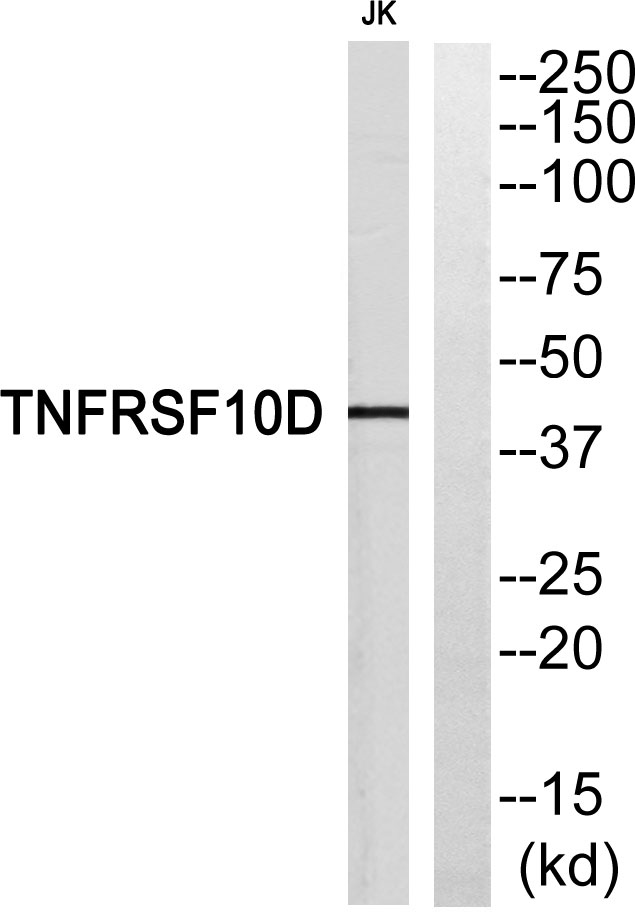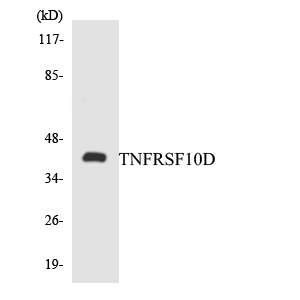CD264 Polyclonal Antibody
- Catalog No.:YT0742
- Applications:WB;ELISA
- Reactivity:Human;Rat;Mouse;
- Target:
- CD264
- Fields:
- >>Cytokine-cytokine receptor interaction;>>Viral protein interaction with cytokine and cytokine receptor
- Gene Name:
- TNFRSF10D
- Protein Name:
- Tumor necrosis factor receptor superfamily member 10D
- Human Gene Id:
- 8793
- Human Swiss Prot No:
- Q9UBN6
- Immunogen:
- The antiserum was produced against synthesized peptide derived from human TNFRSF10D. AA range:121-170
- Specificity:
- CD264 Polyclonal Antibody detects endogenous levels of CD264 protein.
- Formulation:
- Liquid in PBS containing 50% glycerol, 0.5% BSA and 0.02% sodium azide.
- Source:
- Polyclonal, Rabbit,IgG
- Dilution:
- WB 1:500 - 1:2000. ELISA: 1:10000. Not yet tested in other applications.
- Purification:
- The antibody was affinity-purified from rabbit antiserum by affinity-chromatography using epitope-specific immunogen.
- Concentration:
- 1 mg/ml
- Storage Stability:
- -15°C to -25°C/1 year(Do not lower than -25°C)
- Other Name:
- TNFRSF10D;DCR2;TRAILR4;TRUNDD;Tumor necrosis factor receptor superfamily member 10D;Decoy receptor 2;DcR2;TNF-related apoptosis-inducing ligand receptor 4;TRAIL receptor 4;TRAIL-R4;TRAIL receptor with a truncated death domain;CD
- Observed Band(KD):
- 42kD
- Background:
- The protein encoded by this gene is a member of the TNF-receptor superfamily. This receptor contains an extracellular TRAIL-binding domain, a transmembrane domain, and a truncated cytoplamic death domain. This receptor does not induce apoptosis, and has been shown to play an inhibitory role in TRAIL-induced cell apoptosis. [provided by RefSeq, Jul 2008],
- Function:
- function:Receptor for the cytotoxic ligand TRAIL. Contains a truncated death domain and hence is not capable of inducing apoptosis but protects against TRAIL-mediated apoptosis. Reports are contradictory with regards to its ability to induce the NF-kappa-B pathway (According to PubMed:9382840 it cannot but according to PubMed:9430226 it can induce the NF-kappa-B pathway).,similarity:Contains 1 death domain.,similarity:Contains 3 TNFR-Cys repeats.,tissue specificity:Widely expressed, in particular in fetal kidney, lung and liver, and in adult testis and liver. Also expressed in peripheral blood leukocytes, colon and small intestine, ovary, prostate, thymus, spleen, pancreas, kidney, lung, placenta and heart.,
- Subcellular Location:
- Membrane ; Single-pass type I membrane protein .
- Expression:
- Widely expressed, in particular in fetal kidney, lung and liver, and in adult testis and liver. Also expressed in peripheral blood leukocytes, colon and small intestine, ovary, prostate, thymus, spleen, pancreas, kidney, lung, placenta and heart.
- June 19-2018
- WESTERN IMMUNOBLOTTING PROTOCOL
- June 19-2018
- IMMUNOHISTOCHEMISTRY-PARAFFIN PROTOCOL
- June 19-2018
- IMMUNOFLUORESCENCE PROTOCOL
- September 08-2020
- FLOW-CYTOMEYRT-PROTOCOL
- May 20-2022
- Cell-Based ELISA│解您多样本WB检测之困扰
- July 13-2018
- CELL-BASED-ELISA-PROTOCOL-FOR-ACETYL-PROTEIN
- July 13-2018
- CELL-BASED-ELISA-PROTOCOL-FOR-PHOSPHO-PROTEIN
- July 13-2018
- Antibody-FAQs
- Products Images

- Western blot analysis of TNFRSF10D Antibody. The lane on the right is blocked with the TNFRSF10D peptide.

- Western blot analysis of the lysates from K562 cells using TNFRSF10D antibody.



